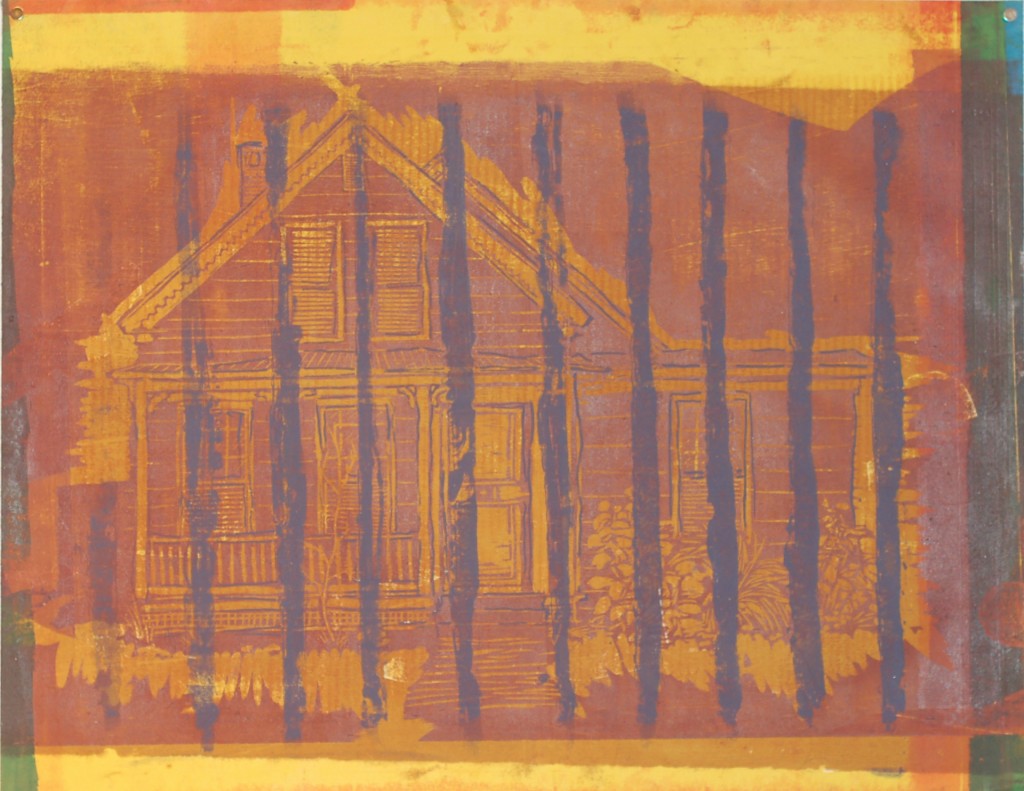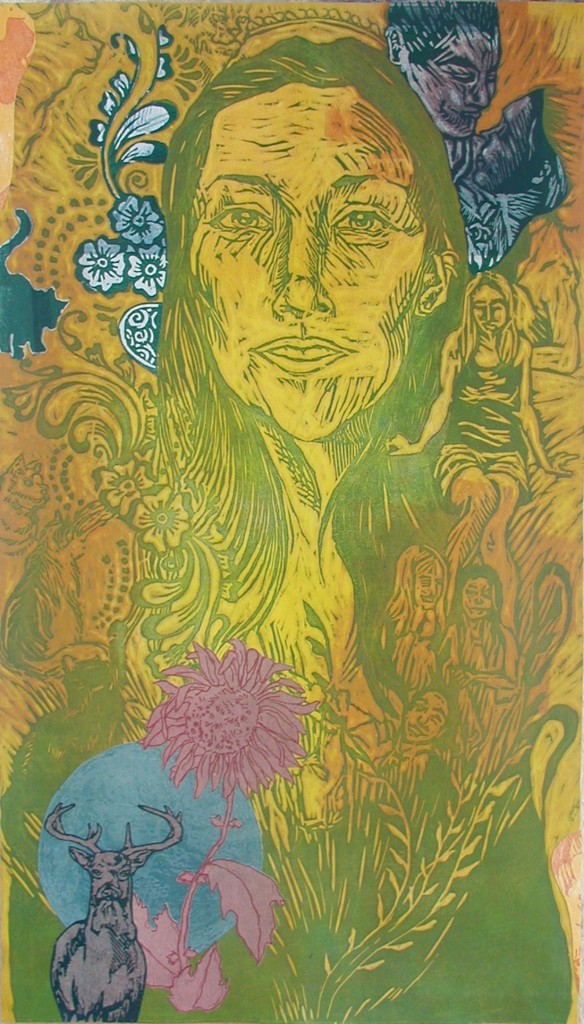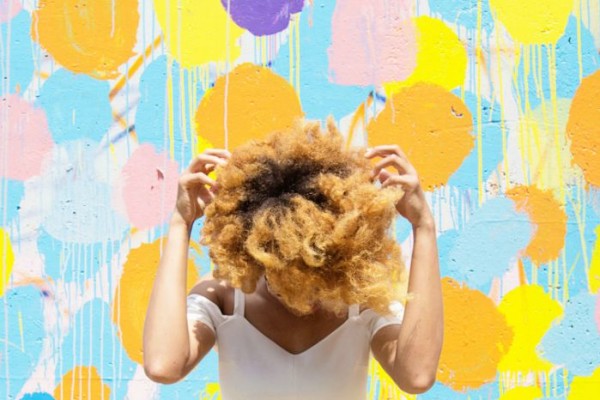 Artist and printmaker Jessica Caldas is taking Atlanta by storm—especially in the past year. She’s scored residencies at MINT’s Leap Year and Printmakers studio; she’s now a WonderRoot Walthall Fellow and continues her work with Elevate Atlanta as well as WonderRoot’s nifty CSA program. (Makes you wonder when she has time to sleep, right?) Caldas discovered the art of printmaking while in school at the University of Georgia and since then, has developed her skills in wood carving and grown as an artist. In between her recent solo show at Beep Beep Gallery and everything else she’s got going on, she also works at the Atlanta Volunteer Lawyers Foundation as program coordinator during the day, helping domestic violence victims get back on their feet.
Artist and printmaker Jessica Caldas is taking Atlanta by storm—especially in the past year. She’s scored residencies at MINT’s Leap Year and Printmakers studio; she’s now a WonderRoot Walthall Fellow and continues her work with Elevate Atlanta as well as WonderRoot’s nifty CSA program. (Makes you wonder when she has time to sleep, right?) Caldas discovered the art of printmaking while in school at the University of Georgia and since then, has developed her skills in wood carving and grown as an artist. In between her recent solo show at Beep Beep Gallery and everything else she’s got going on, she also works at the Atlanta Volunteer Lawyers Foundation as program coordinator during the day, helping domestic violence victims get back on their feet.
CommonCreativ talked to Caldas about patience, staying inspired, her very important a-ha moment and her favorite projects around town.
CommonCreativ: How did you end up as an artist?
Jessica Caldas: My grandfather was an especially avid painter, and although I don’t believe he ever sold his work, I associate his life with being an artist. Painting is just what he did, always, and his house and those of my aunts and uncles are filled with his work. Being an artist always existed alongside other ambitions. For a long time I wanted to be a teacher as well, but I didn’t want to teach art. I just wanted to be a teacher and an artist. I was always like that; whatever else I would be doing would be secondary to being an artist.
CC: Printmaking requires patience. How did you get into it?
JC: I actually “discovered” printmaking in college, during my junior year. It does require patience, but there’s something lovely and wonderful about carving wood. Obviously all art is producing objects of some sort, but carving wood felt more tactile than painting and drawing and I could really get lost in that process. I actually don’t have much patience, so I was surprised to find how much I loved it, and my lack of patience has definitely made learning other printmaking processes more difficult.
The other thing that happened, which solidified my change to the printmaking department, was a visit by Drive by Press. They were this group of guys that traveled all over the county in a van with a printing press. They would print t-shirts, posters, and really anything you wanted them to print (I gave them the jeans I was wearing, my journal, and a handful of other objects to make their mark on) for a fairly cheap price. I spent all day hanging out with them, skipping other classes to do so, and I finally went to the artist’s talk that they gave that evening. They spoke a lot about the democracy of printmaking and how accessible it can be as an art form. I loved that idea and loved their stories of sharing art with people on the road, people who told them that they’d never owned art work or felt welcomed into the art world and were proud to have even a poster from them. To me, that sounded ideal and what I wanted my work to be like. It was something of an a-ha moment.
 CC: What are your favorite materials to work with?
CC: What are your favorite materials to work with?
JC: I love wood. I love trying out different types of wood to see how easy it is to carve, how flaky it is, how soft. I love the way it smells when you’re carving it or when it’s been sitting around your studio for weeks.
CC: How did you prepare for your solo show at Beep Beep Gallery last March?
JC: The work for my Beep Beep solo show was an expansion of a body of work I’d already begun the year before so a lot of the ideas had been circulating in my head for a long time. In a way, the first show was great for getting initial ideas out, trying some things, seeing what worked and what didn’t. The work for Beep Beep was definitely a development—something one step closer to what I want to be saying and sharing on that topic. Right before I began that work, I was commissioned as one of WonderRoot’s CSA artists and my pieces for that project were due in January (about three months before I needed to have work done for the Beep Beep show). A lot of the ideas and successful bits of my work at Beep Beep were directly related to the pieces I turned in for the CSA. Those CSA prints really acted like small studies for new ideas, which was wonderfully fortunate for me.
CC: What’s your thought process when choosing a theme and media for your shows?
JC: My themes always seem to develop out of issues or concerns I have personally. Sometimes I feel like I have less control over that since the things I find important—relationships, social issues, people’s stories, etc.—are really central to my life and, thus, my art work. In the end, the choice is related to how pressing the matter feels. Lately, when I have an idea, I set the prints aside, and I just ask myself, “In what other ways can I say this?” Sometimes I move back to the prints, and sometimes I find other solutions.
 CC: How has your volunteer work affected your perspective and your art?
CC: How has your volunteer work affected your perspective and your art?
JC: I laugh sometimes about how oddly the Atlanta Volunteer Lawyers Foundation (AVLF) came into my life. It wasn’t a job I expected to have for a long time. The fact is, without that job, I would not be the artist I am today. Working so closely to a social issue like domestic violence, I am not sure how anyone can not let it seep into the other aspects of their lives. For me, it meant producing work specifically about the issue, but it wasn’t just that body of work that came out of the job. What really happened was that I figured out what I wanted my work to be about. I realized that I wanted to create work that connected to people, communities and to issues. It seems simple and logical, but I don’t know if I would have realized that so clearly without AVLF.
There is the practical aspect of having a day job with a place like AVLF. I have a salary and thus a freedom of funds I may not have had otherwise. But one of the truest gifts they have given me is support. It’s a small office of no more than 10 staff members. All of them know me as an artist and more often than not, the director will introduce me as such rather than the coordinator of their domestic violence and Guardian ad Litem programs. Everyone I have worked with has attended at least one of my shows and several of them have purchased work from me. They always want to know what is going on with my art life. It’s a lovely family.
CC: Is it difficult to stay inspired and hopeful while being surrounded by domestic violence stories?
JC: I am amazed at the human capacity for hope, but I’m not sure I always stay inspired and hopeful. I used to consider myself an optimist, and now I am not so sure. I know that people are not inherently bad, but in my job you witness some of the worst ways humans can be cruel, not just to strangers, but to people they “love. What does inspire me is the strength of the survivors. For many of our clients, it’s their hope that they can get more, should get more, which finally gets them out and to us. I feel weak compared to many of the people I see on a daily basis.
 CC: You’ve been awarded two artist residencies in Atlanta. How have these helped you grow as an artist?
CC: You’ve been awarded two artist residencies in Atlanta. How have these helped you grow as an artist?
JC: Residencies like the one at APS and Leap Year are insane opportunities. They give you invaluable support, especially when you are young and not really sure what you’re doing. With APS, I can never overlook how wonderful it was to have that opportunity right after exiting from UGA. I really don’t know how else I would have bridged the world of college art-making to real world art-making, even if I still didn’t know what I was doing afterwards. With the Leap Year residency, more than anything, I’ve learned how vital studio space and dialogue can be. The more I embrace this, the more confident I have begun to feel, which is not to say I think I only have good ideas (I have plenty of terrible ones), but I feel more able to explore every idea, to tease it for its value and to know better when it is time to abandon it.
CC: What are your favorite projects in Atlanta right now?
JC: I love the idea behind the WonderRoot CSA. I’m all for collecting work, but also for making work that is accessible (whether by idea or by cost) for a wide audience. I think the CSA makes that possible. Similarly, the work that projects like Flux, Elevate and Dashboard Co-Op do, which bring art into areas that are typically not home to them, makes me giddy with excitement. This is the way it should work, in my mind. I love galleries and museums, but I don’t believe we should expect everyone to visit them.
CC: What are your thoughts in Atlanta’s art scene?
JC: I’m excited that so many organizations are growing, expanding and getting more opportunities. I’m excited at how much support I see for young or local artists, like myself, from small and large organizations. I’m excited that places just outside the city are focusing on contemporary and challenging work, and growing that focus (like Hudgens and Zuckerman).
CC: What’s next for you?
JC: A lot of things! I’m working on wrapping up Leap Year and in the next 3-4 months we’ll be having our final show, our community art project and our public art project. I was also lucky enough to be selected as a 2013-2014 Walthall Fellow so I’ll be working a lot with them and getting geared up for whatever that brings. One of my big goals is to start showing and working outside of Atlanta as well and for me, this is a slow and daunting process. I’m part of a group that was selected for the BeltLine and for Elevate this year, so those projects will start this fall. It’s kind of insane what the next year looks like, actually, but I don’t think I would survive any other way.
See more of Jessica Caldas’ work on her website and follow her on Twitter, @zinkaproject.






